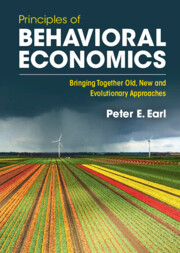Book contents
- Principles of Behavioral Economics
- Principles of Behavioral Economics
- Copyright page
- Contents
- Figures
- Tables
- Preface
- Acknowledgments
- 1 What Is Behavioral Economics?
- 2 What Motivates Us?
- 3 Why Is Life So Full of Problems for Us to Try to Solve?
- 4 How Do We Acknowledge Problems and Assess Options?
- 5 How Do We Deal with Uncertainty and Ambiguity?
- 6 How Do We Search for Solutions to Problems?
- 7 Why Do Some Things Matter More Than Others?
- 8 How Do We Choose?
- 9 How Can Firms and Governments Influence Our Choices?
- 10 What Determines the Productivity of an Organization?
- 11 How Does the Competitive Process Work?
- 12 Are There Any Behavioral Insights for Macroeconomists?
- 13 Can We Be Happy without Destroying the Environment?
- References
- Index
8 - How Do We Choose?
Published online by Cambridge University Press: 18 October 2022
- Principles of Behavioral Economics
- Principles of Behavioral Economics
- Copyright page
- Contents
- Figures
- Tables
- Preface
- Acknowledgments
- 1 What Is Behavioral Economics?
- 2 What Motivates Us?
- 3 Why Is Life So Full of Problems for Us to Try to Solve?
- 4 How Do We Acknowledge Problems and Assess Options?
- 5 How Do We Deal with Uncertainty and Ambiguity?
- 6 How Do We Search for Solutions to Problems?
- 7 Why Do Some Things Matter More Than Others?
- 8 How Do We Choose?
- 9 How Can Firms and Governments Influence Our Choices?
- 10 What Determines the Productivity of an Organization?
- 11 How Does the Competitive Process Work?
- 12 Are There Any Behavioral Insights for Macroeconomists?
- 13 Can We Be Happy without Destroying the Environment?
- References
- Index
Summary
This chapter examines alternative view of how people choose once they have construed what their options offer. It includes critical assessments of one-size-fits-all models from psychology (the Fishbein-Ajzen model of behavioral intentions, which takes account of social pressure, and Prospect Theory, which Thaler popularized in economics) that entail weighing up strong and weak points to arrive at an overall value for each option (“compensatory” choices). However, it suggests these are better seen within a pluralistic, context-based view of choice in which, in some situations, choices are made in intolerant ways based on a checklist or list hierarchically ranked requirements (“non-compensatory” choice) or are made via much simpler decision rules. These different ways of choosing are considered in relation to Chapter 7’s analysis of value systems and that framework is used to analyze how dilemmas are resolved. Differences between choice methods in the role they assign to prices are considered, along with the psychology of pricing and how the use of decision rules reduces challenge of predicting buyer behavior. Case studies are used to show how contexts affect how choices are made.
Keywords
- Type
- Chapter
- Information
- Principles of Behavioral EconomicsBringing Together Old, New and Evolutionary Approaches, pp. 220 - 263Publisher: Cambridge University PressPrint publication year: 2022

